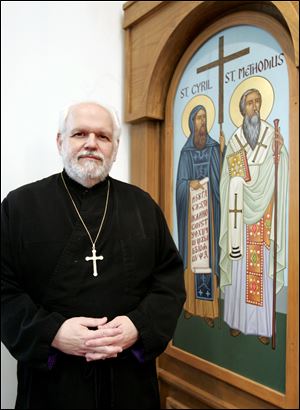
Church follows in missionary footsteps of ancient saints
5/9/2009
The Rev. Paul Gassios said he finds inspiration in the ninth-century missionary work of Ss. Cyril and Methodius.
Can the missionary work of two ninth-century Byzantine Greek brothers serve as a model for evangelism in 21st-century America?
The Rev. Paul Gassios believes so. The pastor of Rossford s St. George Orthodox Cathedral, Orthodox Church in America, he will give a talk on the legacy of Ss. Cyril and Methodius on Monday night, the saints feast day.
The missionary brothers were sent to Moravia, which today is part of the Czech Republic, in 862 by Byzantine Emperor Michael III at the request of Moravian Prince Rastislav, who wanted to bring the Gospel to the Slavs.
The Slavs had no written language at the time, so Saint Cyril spent the first years of his mission assembling a team that created an alphabet, translated the Bible into the native language, and trained and ordained clergy.
Brandon Withrow, a professor at Winebrenner Theological Seminary in Findlay, called Ss. Cyril and Methodius very influential and important figures in history.
He cited Saint Cyril s creation of the Glagolitic alphabet and the fact that the Cyrillic alphabet was named in his honor.
Mr. Withrow said the two Byzantine saints were innovators who were willing to hold discussions with theologians of different faiths, a radical step in that era.
Father Paul said the missionaries never compromised or changed the liturgy in order to accommodate people, but rather took the Byzantine liturgy and transplanted it to a place where there was no existing spiritual culture.
He said he wants to bring Orthodox Christianity to unchurched people who are looking for tradition, consistency, and depth.
We re not growing by leaps and bounds. People are not knocking down the door to join us, Father Paul said in an interview at the cathedral this week. So I think it s led us as a church to ask ourselves, what do we need to do to be growing, to bear witness to our faith?
The church, which has an average attendance of about 80 people, recently formed an evangelism committee with Ss. Cyril and Methodius as patron saints.
Father Paul, 56, who was a social worker before entering the seminary at age 39, was ordained in 1994 and came to St. George on Jan. 1, 2007.
Father Paul, who bears a resemblance to actor Richard Dreyfus, said he looks at the phenomenal growth of the nondenominational, contemporary-styled CedarCreek Church and wonders if it is the only viable solution to modern-day witness of Christianity.
They ve hit a chord with people, people are flocking and going there and they re doing very well. But as with anything, we can never be a CedarCreek. That s not who we are. CedarCreek is speaking to a certain group that has certain needs, Father Paul said.
Unlike the seeker-sensitive Christian churches, which all originated within the last 30 years, the Orthodox church dates back to the start of Christianity.
Our liturgy is the liturgy of the apostles and the nature of liturgy as we practice it today goes back at least 800 years, Father Paul said. There s a lot of continuity in our faith. So the question to me is, how do we bridge this gap?
Orthodox Christianity appeals to people who are looking for stability and depth, he said.
We do live in a McDonald s and McChurch culture today, Father Paul said.
While some people complain that the services too long, he said, they will watch sports on television for endless hours.
We can devote so much time to other things and I don t know if it s really the length of the services as much as what do we hunger for internally, and what are we seeking?
St. George s evangelism committee is looking for ways to take this faith that is so ancient and old and communicate it to people where they re at, to invite them for the ride and bring them along with love.
He said Ss. Cyril and Methodius advocated for the people and loved the people they were sent to. The saints devoted their lives to serving the Moravian people and their work was endorsed by the Byzantine emperor, the Orthodox patriarch, and the Roman Catholic pope.
Yet when they died Cyril in 869 at age 42 and Methodius in 885 at age 59 their work in Moravia was wiped out by Frankish rulers and clergy who wanted the liturgy to be celebrated only in Latin, Greek, or Hebrew, not the native Slavonic tongue.
It was the saints colleagues, arrested and enslaved, who took Ss. Cyril and Methodius missionary work to Bulgaria, where it flourished and eventually spread to Russia.
They would not have seen the fruit of their labors. They would have seen that everything was a total failure and what they did in Moravia was undermined. But the very people that were rejected and cast out and sold into slavery became the basis through with Eastern Christianity was spread to the Slavic world, he said. It ain t over until the fat lady sings.
The Rev. Paul Gassios will speak on The Legacy of Ss. Cyril and Methodius: What We Can Learn from their Experiences as Missionaries, after 6:30 p.m. Great Vespers Monday at St. George Orthodox Cathedral, Orthodox Church in America, 738 Glenwood Rd., Rossford. Information: 419-662-3922.
Contact David Yonke at:dyonke@theblade.com or 419-724-6154.